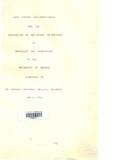| dc.contributor.author | Kibunguchy, Wahauja | |
| dc.date.accessioned | 2014-06-25T10:31:04Z | |
| dc.date.available | 2014-06-25T10:31:04Z | |
| dc.date.issued | 1985 | |
| dc.identifier.citation | Degree of Masters of Medicine, University of Nairobi, 1985 | en_US |
| dc.identifier.uri | http://hdl.handle.net/11295/71072 | |
| dc.description.abstract | Nutritional anaema is defined by W.H.O. as, "A condition in
which the haemoglobin concentration of blood is below the accepted
normal value, due to a deficiency of one or more nutrients essential
for erythropoiesis, regardless of the cause of the deficiency" (I).
The materials essential for erythropoiesis, deficiencies of which
are responsible for anaemia in pregnancy anywhere in the world, are,
broadly iron and folic acid, and occasionally vitamin B12 (2).
The importance of anaemia as a leading cause of morbidity and
mortality at the coastal regions of Kenya has been well documented
(3-8). Malaria (9) and hookworm infection (10) being endemic in these
areas, would undoubtedly playa major role in the aetiology of anaemia
in pregnancy. This study was undertaken to evaluate t he part played by
these two parasites plus other determinants of anaemia in pregnancy
at the coast | en_US |
| dc.language.iso | en | en_US |
| dc.publisher | University of Nairobi | en_US |
| dc.title | Anaemia In Pregnancy At Coast Province General Hospital(CPGH), Mombasa : A Descriptive Study | en_US |
| dc.type | Thesis | en_US |
| dc.description.department | a
Department of Psychiatry, University of Nairobi, ; bDepartment of Mental Health, School of Medicine,
Moi University, Eldoret, Kenya | |

